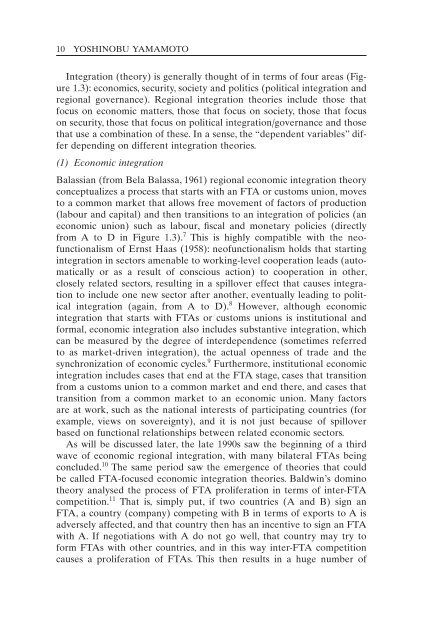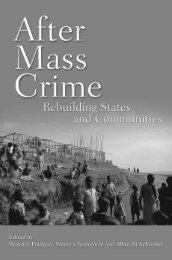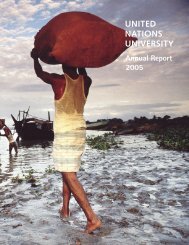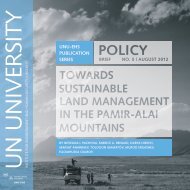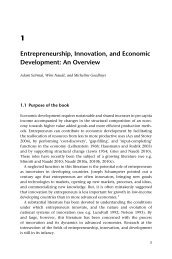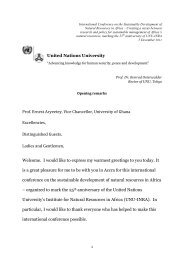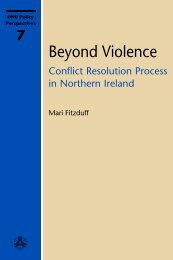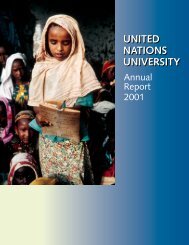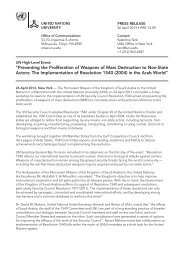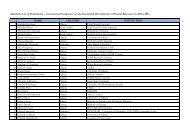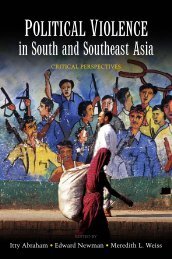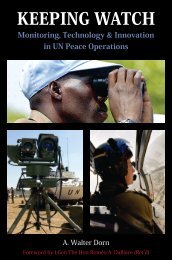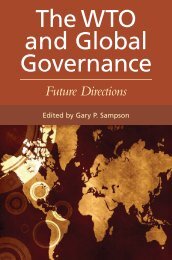Sample Chapter - United Nations University
Sample Chapter - United Nations University
Sample Chapter - United Nations University
You also want an ePaper? Increase the reach of your titles
YUMPU automatically turns print PDFs into web optimized ePapers that Google loves.
10 Yoshinobu Yamamoto<br />
Integration (theory) is generally thought of in terms of four areas (Figure<br />
1.3): economics, security, society and politics (political integration and<br />
regional governance). Regional integration theories include those that<br />
focus on economic matters, those that focus on society, those that focus<br />
on security, those that focus on political integration/governance and those<br />
that use a combination of these. In a sense, the “dependent variables” differ<br />
depending on different integration theories.<br />
(1) Economic integration<br />
Balassian (from Bela Balassa, 1961) regional economic integration theory<br />
conceptualizes a process that starts with an FTA or customs union, moves<br />
to a common market that allows free movement of factors of production<br />
(labour and capital) and then transitions to an integration of policies (an<br />
economic union) such as labour, fiscal and monetary policies (directly<br />
from A to D in Figure 1.3). 7 This is highly compatible with the neofunctionalism<br />
of Ernst Haas (1958): neofunctionalism holds that starting<br />
integration in sectors amenable to working-level cooperation leads (automatically<br />
or as a result of conscious action) to cooperation in other,<br />
closely related sectors, resulting in a spillover effect that causes integration<br />
to include one new sector after another, eventually leading to political<br />
integration (again, from A to D). 8 However, although economic<br />
integration that starts with FTAs or customs unions is institutional and<br />
formal, economic integration also includes substantive integration, which<br />
can be measured by the degree of interdependence (sometimes referred<br />
to as market-driven integration), the actual openness of trade and the<br />
synchronization of economic cycles. 9 Furthermore, institutional economic<br />
integration includes cases that end at the FTA stage, cases that transition<br />
from a customs union to a common market and end there, and cases that<br />
transition from a common market to an economic union. Many factors<br />
are at work, such as the national interests of participating countries (for<br />
example, views on sovereignty), and it is not just because of spillover<br />
based on functional relationships between related economic sectors.<br />
As will be discussed later, the late 1990s saw the beginning of a third<br />
wave of economic regional integration, with many bilateral FTAs being<br />
concluded. 10 The same period saw the emergence of theories that could<br />
be called FTA-focused economic integration theories. Baldwin’s domino<br />
theory analysed the process of FTA proliferation in terms of inter-FTA<br />
competition. 11 That is, simply put, if two countries (A and B) sign an<br />
FTA, a country (company) competing with B in terms of exports to A is<br />
adversely affected, and that country then has an incentive to sign an FTA<br />
with A. If negotiations with A do not go well, that country may try to<br />
form FTAs with other countries, and in this way inter-FTA competition<br />
causes a proliferation of FTAs. This then results in a huge number of


